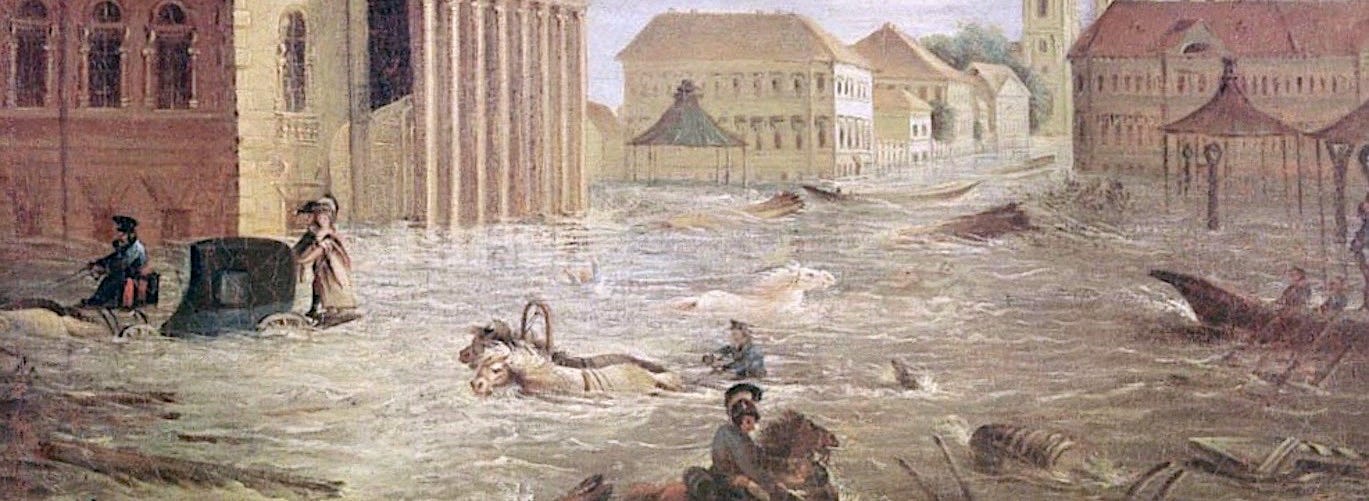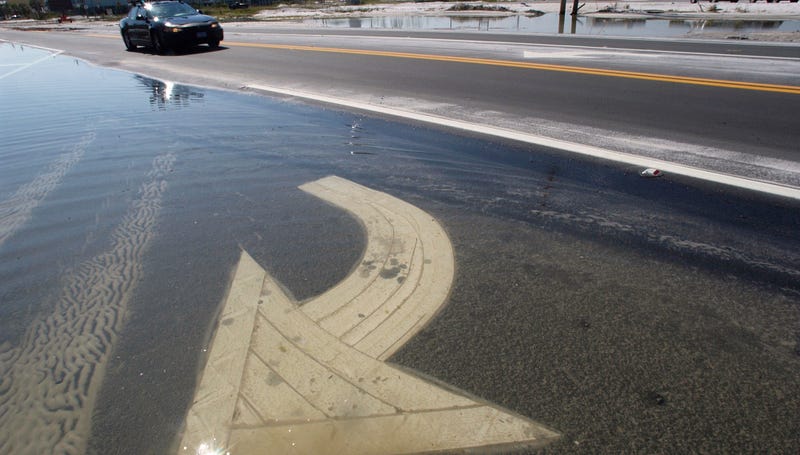The 1824 flooding for St. Petersburg, Russia.
Once-a-century floods could become commonplace as the planet heats up.
From NexusMedia by Marlene Cimons
Sea-level rise threatens coastal communities.
The
kind of devastating flooding that occurs once every century along
Europe’s northern coastline could become an annual event if greenhouse
gas emissions continue to climb, according to a recent study published in the journal Earth’s Future.
New
analysis takes into account changes in sea-level rise, tides, waves and
storm surge over the 21st century and found that climate change could
prompt extreme sea levels — the maximum levels seen during major storms,
which produce massive flooding — to increase significantly along the
European coastline by 2100.
This
scenario will likely stress coastal protection structures beyond their
capacity, leaving much of the European coastline vulnerable to dangerous
flooding, according to study authors.
“Unless
we take different protection measures, five million people will be
exposed to coastal flooding on an annual basis,” said Michalis
Vousdoukas, a coastal oceanographer at the Joint Research Centre of the
European Commission and lead author of the study.
The
study described the projected rise in extreme sea levels as “a serious
threat” to coastal communities, noting, “their safety and resilience
depends on the effectiveness of natural and man-made coastal flood
protection.”
Kevin
Trenberth, a scientist with the climate analysis section of the
National Center for Atmospheric Research, who was not involved in this
research, said the signs of extreme sea levels are already worrisome,
not just in Europe, but in the United States as well.
“Witness the sunshine flooding
in Florida already, the flooding that shows up even with no storm on
many streets any time there is a slightly high tide,” he said.
A Florida road flooded by tropical storm Arlene in 2005.
Florida is especially susceptible to rising seas.
Source: FEMA
“Sea
level is going up because the ocean is warming and hence expanding, and
because land ice — glaciers, etc. — are melting and putting more water
into the ocean. But it is not the gradual rise that matters,” Trenberth
said. “Rather, it is the storm surge on top of a high tide riding on top
of the increase in sea level that crosses thresholds and causes things
to break.”
Richard
Alley, professor of geosciences at Pennsylvania State University, who
also did not take part in this study, noted that the study didn’t
consider the possible collapse of the West Antarctic ice sheet. “If that
happens, then sea-level rise and impacts to coasts could be much higher
than in this paper,” Alley said. “Rapid West Antarctic collapse could
cause enough rise to make many of these other factors of secondary
importance. So, the ‘worst case’ in this paper isn’t really the worst
case.”
The
new paper predicted that some regions could experience an even higher
increase in the frequency of these extreme flooding events, specifically
along the Mediterranean and the Black Sea, where the present day
100-year extreme sea level could occur as often as several times a year.
Information
about the number of people at risk from flooding can be used to
determine how large the social and economic impact of these events will
be, said Marta Marcos, a researcher at the Mediterranean Institute for
Advanced Studies in Spain, who was not involved in the new study. “In
terms of adaptation strategies and policy-making, it is very relevant,”
she said.
The
researchers studied changes in extreme sea levels by 2100 under
different greenhouse gas scenarios and considered how all these
components — mean sea level, tides, waves and storm surge — will be
affected by climate change.
The Netherlands is particularly vulnerable to sea-level rise.
Source: Pexels
If
emissions continue to rise unabated throughout this century, extreme sea
levels along Europe’s coastlines could increase by more than 2.5 feet,
on average, by 2100.
Under a more moderate situation, where greenhouse
gas emissions peak in 2040, 100-year extreme sea levels still could jump
by nearly 2 feet, on average, by the end of the century — with flooding
events occurring every few years — according to study’s authors.
In a related study appearing in Geophysical Research Letters,
scientists found that if greenhouse gases continue to rise, there could
be disturbing changes by the end of the century in the energy that
waves carry to the coast.
In
the southern hemisphere, extreme waves could carry up to 30 percent
more energy by 2100, according to the study, meaning that stronger waves
will become more frequent, and have a greater impact on the coast, said
Lorenzo Mentaschi, a researcher at the Joint Research Centre and lead
author of the study.
The
new study attributed the changes in wave energy to the intensification
of weather patterns, like El Niño.
The new research will be provided to
European Union policymakers.
The data will also be made public so it can
be used by scientists, engineers and coastal managers.
Michael
Mann, professor of atmospheric science at Pennsylvania State
University, said the research once again underscored how climate change,
“which has already increased the threat to our coastlines through a
combination of sea-level rise and intensified coastal storms, will be
catastrophic for coastal communities if we don’t reduce global carbon
emissions.”
Links :
- ScienceDirect : Sea-level rise impacts on the tides of the European Shelf
- The Conversation : How Europe’s coastal cities can cope with rising sea levels
- New Scientist : Internal migration of millions as seas rise will rattle whole US
- Phys : Climate experts release latest science on sea level rise projections
- SFGate : Sea-level rise in California could be catastrophic, study says
- NYTimes : When rising seas transform risk into certainty
- PopScience : As sea levels rise, where will all the people go?
- GeoGarage blog : Five Pacific islands lost to rising seas as climate change ... / The biggest threat to NASA's future is the ocean / New data reveal stunning acceleration of sea level rise / Going Dutch to help conquer the rising seas / New report and maps: Rising seas threaten land home to ... / Map shows where Sea Level rise will drown American cities / 15 facts about sea level rise that should scare the s ... / U.S. cities lag in race against rising seas / Interactive flood map predicts sea level rise / Rising sea levels: Is global warming making the US East ... / Surging seas maps sea level rise in Coastal U.S. / Rising seas will affect major U.S. coastal cities by 2100 / Year after Sandy, rebuilding for storms and rising seas / The old man and the rising sea / Rising seas, vanishing coastlines / Future disasters: 10 lessons from superstorm Sandy / New York at risk from combination of rising seas and ... / Losing paradise: the people displaced by atomic bombs ...



No comments:
Post a Comment